|
|
| | My Favourite Planet > English > Europe > Greece > Macedonia > Stageira & Olympiada > Stageira gallery |
| Stageira & Olympiada |
Ancient Stageira gallery |
 |
 |
30 of 38 |
 |
 |
|
| |
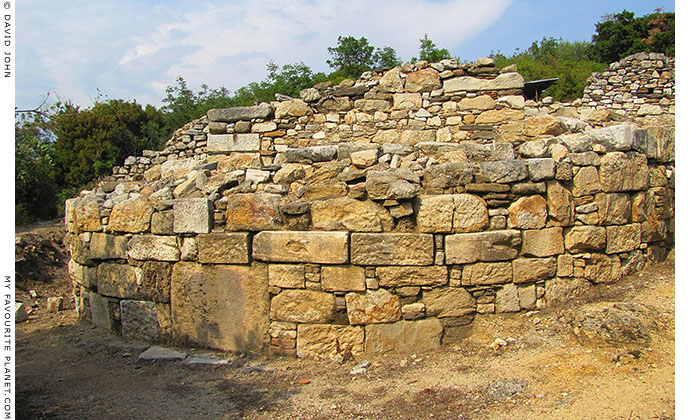
Hellenistic building with a curved (apsidal) front on the North Hill of Stageira. |
| |
Behind and above the stoa of Stageira's agora, on the southern slope of the city's North Hill, is a large building (9 x 10 metres) with a curved (apsidal) outer end wall, dated to the early Hellenistic era, 4th or early 3rd century BC. The function of this building has not yet been discovered, but the archaeologist Konstantinos Sismanidis, who directed excavations at Stageira 1990-2000, believes it may have been the tomb of Aristotle known as "the Aristoteleion", at which the philosopher was honoured by an annual festival called the "Aristoteleia" (see Olympiada gallery page 5).
The site around the building is quite complicated, as foundations and stones from structures of previous eras - as far back as the Archaic period - have been reused, perhaps several times. At this level of the North Hill a straight Middle-Byzantine (10-11th centuries AD) wall was built across the peninsula, connected to the ancient perimeter wall protecting the north of the city. The Byzantines also built a square tower inside the ruins of the Hellenistic building (see photo below).
The North Hill of Stageira is the oldest part of the city founded by colonists from Andros and Chalki in 655 BC, during the Archaic period (see History part 2). Archaeologists have established that the foundations of the defensive walls around the hill date back to this Archaic phase of the city's development.
The remains of an Archaic gateway have been discovered halfway along the Byzantine wall, just to the right (east) of the Hellenistic building. The two ends of the gate's marble lintel, estimated to have been about 2.5 metres long, were found here. It seems that it fell to the ground and broke at some time. Significantly, the lintel was carved with a relief of a large boar (Greek, kάπρος, kapros), the symbol of Stageira, on the left side, facing a lion on the right (see photos below). The image of a lion attacking a boar is also known from early coins of Stageira (see Olympiada gallery page 2). Part of a 6th century BC inscription was also preserved on the lintel, with script chiselled in "boustropheon", i.e. written from left to right and right to left on alternate lines. [1] The surviving fragments of the lintel are now in the Thessaloniki Archaeological Museum, while many other finds from Stageira are in the Archaeological Museum of Polygyros, in central Halkidiki.
Among this complex of buildings, a marble mosaic floor has also been unearthed. See next page. |
|
|
| |
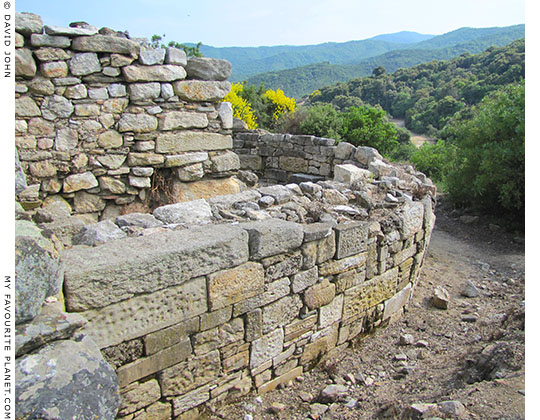
The north side of the Hellenistic building and the square Byzantine tower
built within it. See the interior of the Byzantine tower on the next page. |
| |
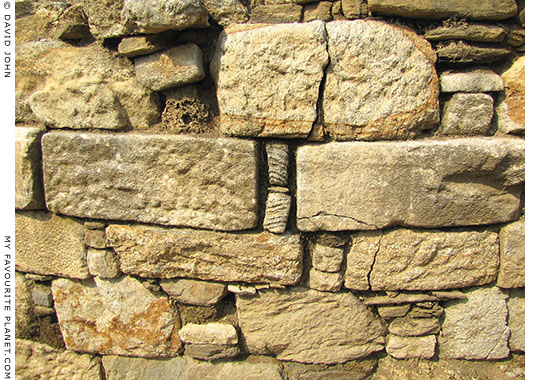
Detail of the irregular masonry of the Hellenistic building. |
|
| |
 |
|
|
| |
| |
 |
| |
 |
| |
 |
| |
 |
| |
George Alvanos
rooms in
Kavala's historic Panagia District
Anthemiou 35,
Kavala, Greece
kavalarooms.gr
|
| |
 |
| |
 |
| |
Olive Garden Restaurant
Kastellorizo,
Greece
+30 22460 49 109
kastellorizo.de
|
| |
Papoutsis
Travel Agency
Kastellorizo,
Greece
+30 22460 49 286
greeklodgings.gr
|
| |
| |
| |
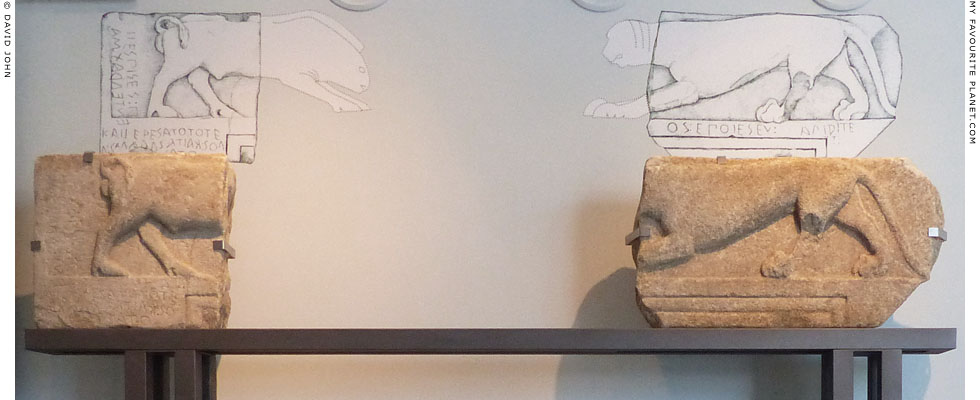
The two surviving end fragments of the inscribed marble lintel of a 6th century BC gate from Stageira.
Thessaloniki Archaeological Museum.
|
It is thought that the gateway, built along the city's Archaic walls, remnants of which have survived, may have one of the main gates or even the main gate itself. The lintel is around 55 cm high and estimated to have been about 2.5 metres long. The two ends of the lintel are decorated with reliefs of the bodies and hind legs of a large boar (left) and a lion (right) confronting each other. The central section of the lintel, with their heads and perhaps other motifs, may have been destroyed or reused elsewhere. The lintel fragments also bear inscriptions (see details below).
The dating of the relief of a lion and a boar to before the conquest of Halkidiki by the Persians (see History of Stageira and Olympiada Part 4) appears to contradict theories that coins of Stageira and other cities such as Akanthos, showing a lion attacking the local sacred animal (see History of Stageira and Olympiada Part 3), were related to Persian Achaemenid iconography, known from the monumental reliefs at Persepolis. It seems more likely that the motif belongs to the Greek tradition which predates the arrival of the Persians by at least a thousand years (see photos below).
The fragments were discovered in 1996, during the excavations of 1990-2000, directed by Konstantinos L. Sismanidis (Κωνσταντίνος Λ. Σισμανίδης), but only publicly exhibited for the first time in the Thessaloniki museum in 2016 during the UNESCO "Aristotle Anniversary Year" (strangely proclaimed as commemorating "2400 years since the birth of the great Macedonian philosopher", although his birthdate in 384 BC is undisputed). In the long interval they had been kept in a storeroom. It seems an odd decision to have kept these important artefacts, which are rare examples of Archaic sculpture, architecture and document, locked away for so long rather than displaying them, for example at the Polygyros museum. As the museum documentation states:
"The lintel, a rare find for northern Greece, is an important example of monumental sculpture of the Archaic period (700-480 BC)." [2]
In keeping with current museum trends, the pieces are displayed on top of a metal stand over 2 metres high to give visitors the impression of how they would have appeared on top of the gateway, as well as make the artefacts appear more impressive. This approach is questionable, to say the least, as it adds little or nothing to our understanding of the artefacts, and makes it more difficult to examine the objects, or appreciate fine details and inscriptions. |
|
| |
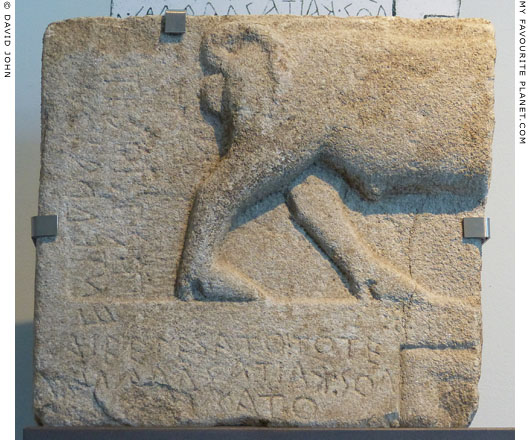
The left-hand fragment of the gate lintel from Stageira with part
of a relief of a wild boar (κάπρος, kapros), the symbol of Stageira).
Thessaloniki Archaeological Museum. Inscriptions SEG 48-840.
|
| The 6th century BC inscription to the left and below the boar is written in boustropheon, both vertically and horizontally, filling the space at the end of the lintel. The inscription is a decree concerning tax relief, according to which an archon named Thespis reduced tax to five drachmas and abolished other charges. |
|
| |
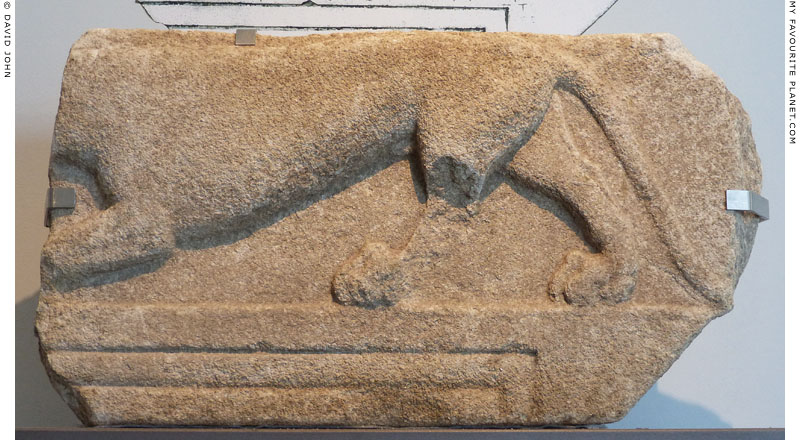
The right-hand fragment of the gate lintel from Stageira, with a part of a relief of a lion.
Thessaloniki Archaeological Museum.
|
The inscription below the lion's feet is badly worn and difficult to discern. It has been read as:
...ΟΣ: ΕΠΟΙΕΣΕΝ: [ΣΤ]ΑΓΙΡΙΤΕ[Σ]
The first incomplete word ...OS is thought to be the end of the name of the sculptor who made (EPOIESON) the relief, and the last word is thought to be the name Stageira ([ST]AGIRITE[S]). Artists' signatures on Archaic sculptures are very rare, but see for example Polymedes of Argos and Aristokles. |
|
| |
Ancient Stageira
gallery |
Notes, references and links |
 |
|
1. Boustrophedon
The word boustrophedon comes from the Greek βουστροφηδόν, "ox-turning", from βοuς (bous) "ox", στροφή (strophe) "turn" and δόν (don) an adverbial suffix, and means turning in the opposite direction as an ox at the end of each row of ploughing.
In the study of ancient manuscripts and inscriptions it denotes texts in which the direction of the writing changes direction on every other line: one line is written from left to right, and the next from right to left, with the letters reversed. Boustrophedon appears in texts from several ancient cultures. In Greece it was used mainly in the Archaic period (from the 8th to the beginning of the 5th centuries BC), and gradually less through the Classical and Hellenistic ages.
2. Thessaloniki Archaeological Museum
In defence of the excellent Thessaloniki museum, one of the best in Greece, it must be said that it has been evolving and improving rapidly over the last decade, with a number of redesigns and redeployments of its exhibits, and there are now many more fascinating objects to be seen than ever before. The staff have also made great efforts to provide useful labelling, information boards and videos in Greek and English, explaining historical, geographical and social contexts of the exhibits. A new book on the museum would be most welcome, as well as an online database of the collection. |
|
|
| |
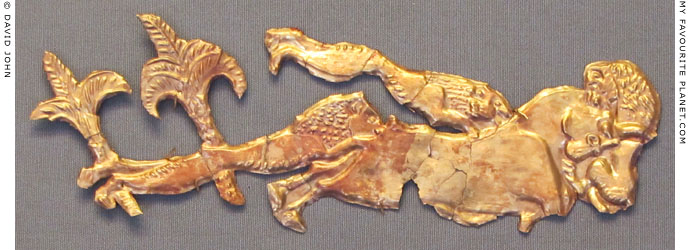
A gold cut-out depicting two lions attacking a bull among palm trees.
Mycenaean, 16th century BC. From Grave III ("Grave of the Women"),
Grave Circle A, Mycenae, Peloponnese, Greece.
National Archaeological Museum, Athens. Inv. No. 29. |
| |
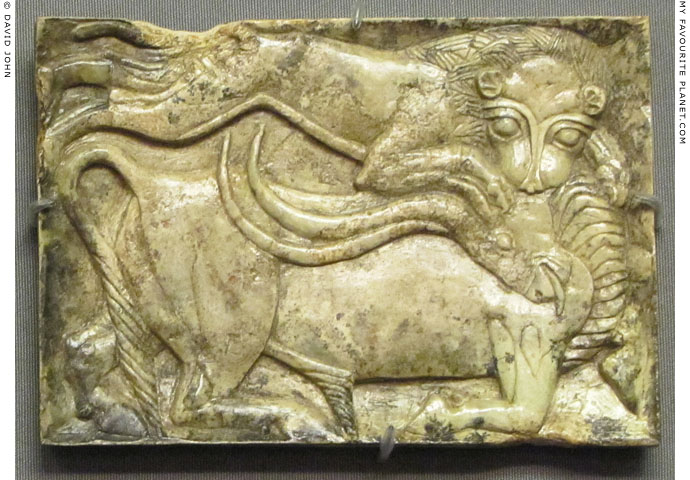
An ivory plaque depicting a lion attacking a bull.
14th - 13th century BC. One of a number of similar plaques
discovered in chamber tombs at Spata, Attica, Greece.
National Archaeological Museum, Athens. Inv. No. 2046. |
| |
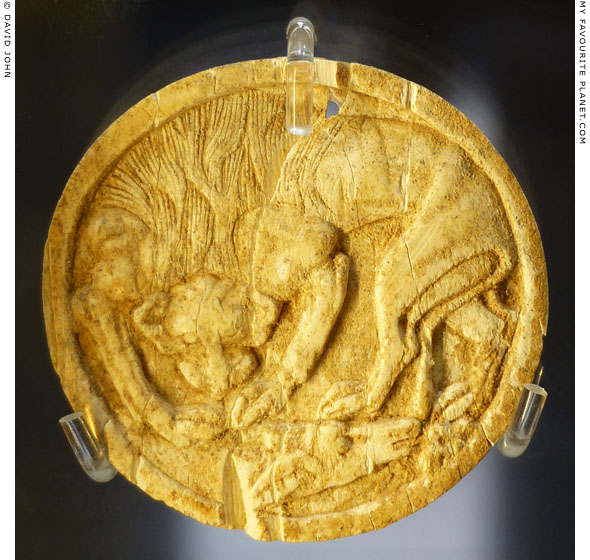
An ivory pyxis lid with a carved relief depicting a lion attacking a bull.
14th - 13th century BC. From the cemetery of the
Kastellia hills, Thebes, Boeotia, central Greece.
Thebes Archaeological Museum, Athens. |
| |
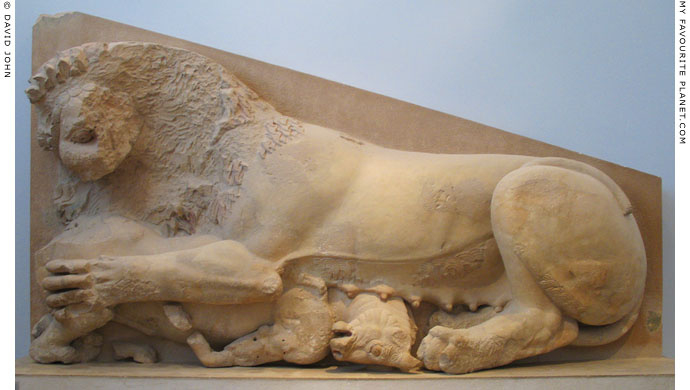
Fragment of a poros (limestone) high relief of a lion attacking a bull or calf.
Around 570-550 BC. Found in 1888 east and southeast of the Parthenon.
Thought to be from the east pediment of the Archaic pre-Parthenon temple
of Athena on the Athens Acropolis, known as the Hekatompedon or Hekatompedos
(ἑκατόμπεδος, hundred-footer), also referred to as Ur-Parthenon and Building H.
Acropolis Museum, Athens. Inv. No. 4. |
| |
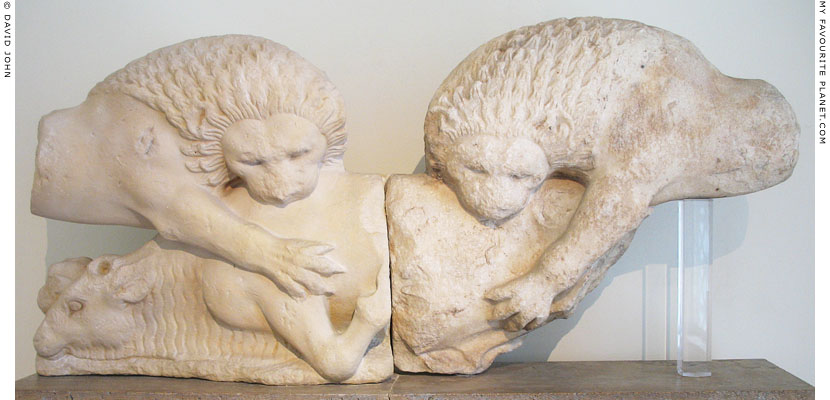
Parts of a high marble pedimental relief of two lions attacking a bull.
Around 500 BC. Found at the Olympieion, Athens. Parian marble. The left part
is a plaster cast of the piece now in the Metropolitan Museum, New York.
National Archaeological Museum, Athens. Inv. No. 1673. |
| |
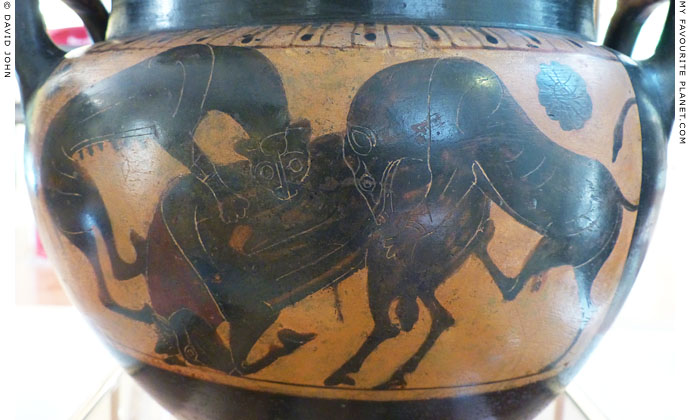
A lioness (left) and a lion attacking a bull on an Attic black-figure column-krater
with Corinthian influence. The bull's neck is painted in red.
Second half of the 6th century BC. From Akragas (Agrigento), Sicily.
Agrigento Regional Archaeological Museum, Sicily. |
| |
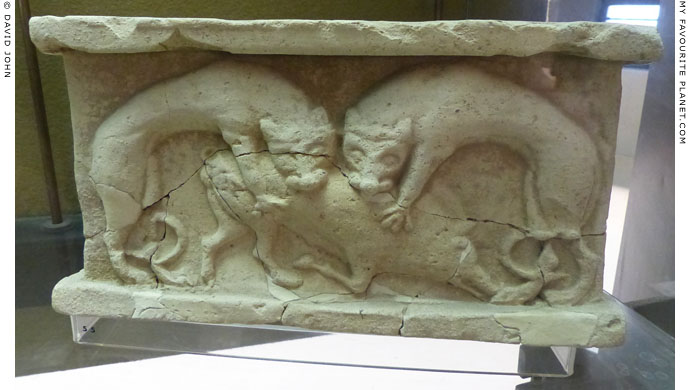
A terracotta altar with a relief of two cats (lionesses?) attacking a boar.
6th century BC. From Megara Hyblaea, Sicily, a colony of Megara in central Greece.
Paolo Orsi Regional Archaeological Museum, Syracuse, Sicily.
See also a relief of a lioness attacking a bull on a ceramic altar from Gela, Sicily, 500-480 BC. |
| |
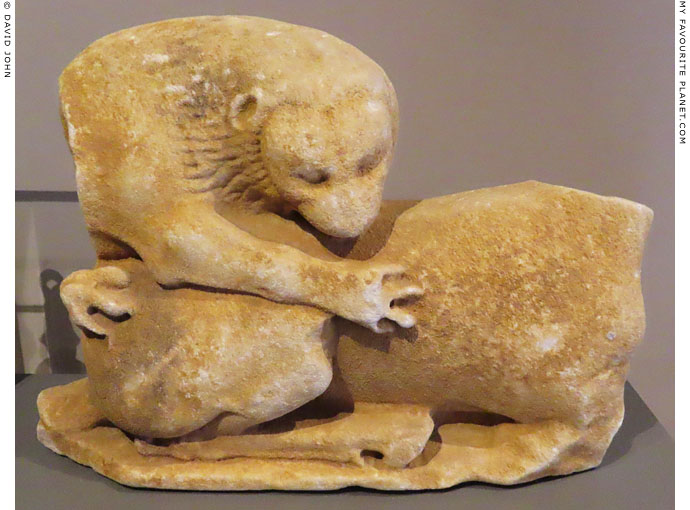
A high relief of a lion attacking a deer from the pediment of the Archaic temple
of Athena at Platanistos, Karystia, southeast Euboea, central Greece.
6th century BC. Found during excavations in the early 20th century.
Chalkis, New Archaeological Museum "Arethousa". Inv. No. MX 102.
Formerly in the Archaeological Museum of Chalkis (now referred to as the "old museum"). |
Photos, maps and articles: copyright © David John,
except where otherwise specified.
Additional photos: copyright © Konstanze Gundudis
All photos and articles are copyright protected.
Images and materials by other authors
have been attributed where applicable.
Please do not use these photos or articles without permission.
If you are interested in using any of the photos for your website,
project or publication, please get in contact.
Higher resolution versions are available on request.
My Favourite Planet makes great efforts to provide
comprehensive and accurate information across this
website. However, we can take no responsibility for
inaccuracies or changes made by providers of services
mentioned on these pages. |
| |
 |
Visit the My Favourite Planet Group on Facebook.
Join the group, write a message or comment,
post photos and videos, start a discussion... |
|
|
| |
| Copyright © 2003-2025 My Favourite Planet | contributors | impressum | contents | sitemap |
| |


























